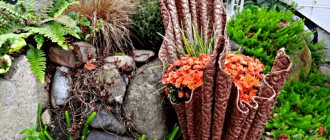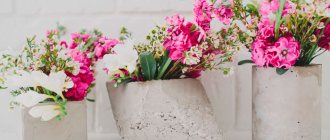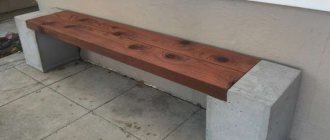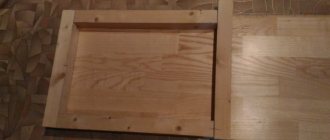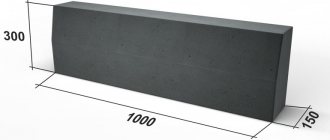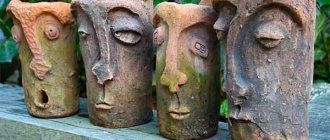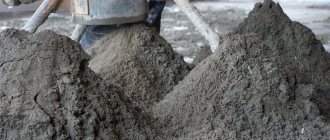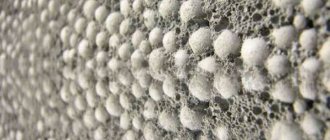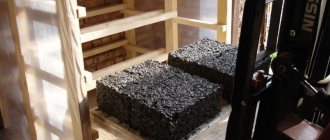Beton-House.com
Website about concrete: construction, characteristics, design. We combine the experience of professionals and private craftsmen in one place
Concrete vases are becoming increasingly popular as home decorations.
Concrete flower beds help to decorate a garden plot, design a local area, limit and set the direction of movement, and simply landscape the area. The variety of shapes and possible finishing solutions allows you to use outdoor concrete vases on any surface with an even surface.
A concrete planter will fit well into the landscape of a green lawn, will look great on paving stones, paving slabs and will decorate an ordinary asphalt path. How to make a flowerpot on your own, and what nuances need to be taken into account, we will consider in this article.
- Important nuances
- Coloring
Features of concrete flower beds
Concrete flower beds are used almost everywhere; there are no restrictions on their use. They are made from high-strength materials and placed on objects for various purposes. Here it is important to be able to choose the right design solution so that the concrete structure has the most advantageous appearance and is an additional decorative element.
Outdoor concrete flower beds are presented in a wide variety of variations; they can differ in both shape and size. They are used as a kind of space delimiter, to create an accent against the background of a green carpet - lawn, flower crops. Concrete flower beds are also chosen for landscaping because they can be painted multiple times. Their surface can be either smooth or embossed. Installation of a cement flower bed can be done in several ways:
- To the surface. Due to its serious weight, a concrete flower bed is able to occupy a strong position even without additional supports or fastenings.
- By digging into the ground. Thanks to this technique, you can create an original multi-level flowerbed, or adjust its dimensions to the required size.
- By means of formwork equipment in the ground. This design can have high sides or go completely into the ground, allowing you to build diverse flower beds. Cement mortar is poured into this formwork and, after drying, painted if necessary. Ornamental crops in this case can also be of different sizes and in different quantities. As an option, you can make a flowerbed in the form of a specific design or pattern.
Advantages
Among the positive characteristics of concrete flower beds are:
- high degree of resistance to negative environmental factors (excessive humidity, precipitation);
- excellent strength qualities;
- long service life (almost 50 years);
- high aesthetic qualities;
- saving yard space when using vertical concrete compositions;
- use as a sustainable barrier;
- the possibility of creating multi-level flower beds;
- easy to paint;
- possibility of making it yourself;
- ease of care.
Important! When decorating a concrete flower garden, you can use small pebbles, glass mosaics, and paints and varnishes. To create an ornament, just use a sharp tool.
Flaws
The disadvantages of cement flower beds include:
- large size;
- large mass;
- the need for decorative processing;
- difficulty in moving to another place.
If there is a need to make an elegant flower garden, then instead of cement it is recommended to use more suitable materials, for example, gypsum.
Finishing
The finishing of the finished bowl can be very diverse - it all depends on desires and possibilities. In Moscow and the regions today you can find a variety of decorative elements, garden accessories, and beautiful little things, so decorating a concrete flowerpot turns into an exciting process.
Basic decoration methods:
- Coloring
– at the stage of mixing the solution or after drying, it can be a solid color or painted
- Mosaic
– using glass, mirrors, stained glass, broken dishes, etc.
- Laying out
– stones, shells, coins, etc.
- Changing the texture
– sanding for roughness or polishing with emery
- Making stands
in the form of open palms (rubber gloves are filled with concrete) or large leaves (the solution is laid out on huge leaves)
- Playing with shapes and sizes
– when there are a lot of flowerpots, they themselves can create an original composition and become a decoration for the site
The decor must be durable, reliable, resistant to precipitation and frost. Therefore, ordinary glue is not used in the work, and the fastening of the elements is made from suitable materials.
Ready-made concrete flower beds
The market offers ready-made concrete flower beds that can either be dug into the ground or installed on a flat surface. There are rectangular concrete flower beds, as well as products in the shape of a vase, bowl, and various geometric shapes. A basket flowerbed made of concrete looks especially interesting near the house, on garden paths. A cement flower bed should not be buried in the ground; it is best to paint a concrete flower bed.
Ready-made concrete forms no longer require labor for their production and are completely suitable for garden design. They are manufactured according to technology, have a sufficient level of resistance to temperature changes, precipitation, and are easy to treat with disinfectants, which are used in the fall, when the plants fade.
One of the varieties of cement flower gardens is decorative concrete blocks. They are ideal for arranging flower beds, which are intended for the construction of supporting walls using the dry laying method. There are blocks with special holes through which connecting rods are pulled. There are also models that need to be compacted. The undeniable advantage of such a building material as concrete is its ease of use. Such products have smooth edges, and assembly of the structure does not cause any particular difficulties.
To create a flower garden on a personal plot, any materials that are resistant to adverse environmental factors, but with drainage, are quite suitable. The most common option for constructing flower beds is concrete drainage pipes, which are installed in a vertical position. They look worthy in solo performance, where each is planted with a decorative bush or tree, and in a group composition with perennial plants.
Species diversity of wells
Currently, there are several main, most popular and popular types:
- ascending key;
- descending key;
- mine wooden;
- mine concrete;
- mine brick;
- mine stone;
- pipe structures;
- drilling or pipe structures.
A variety of materials can be used for arrangement, including:
- clay;
- wood;
- rubble stone;
- cobblestones and boulders;
- brick;
- flagstone;
- gravel or crushed stone;
- concrete solution;
- reinforced concrete.
Most often, wells or wells on a site are the best option for water production in the absence of centralized communications, so it is very important to determine what types of water supply sources are suitable for each specific site. When choosing, you will need to take into account the type of soil, the depth of the aquifer and other important factors.
Forms for pouring concrete flower beds
To make a round flowerbed from concrete or any other shape, you can use ready-made molds or make them yourself.
Purchased forms
Molds made of plastic and silicone are available for sale; they are easy to use and have a wide range. To make a concrete flower bed, it is enough to assemble a mold, lubricate it with oil for easier removal of the product, and fill it with cement mortar. After two days, the concrete mass should harden and the form can be removed. But given the high cost of such products, it is more advisable to purchase them if not one, but a large number of flowerpots are made.
Forms from improvised means
This solution is budget-friendly; any plastic container can be used to make flower beds. They are also lubricated inside with oil, a bucket of stones is placed in the center for better stability, and the space around it is filled with concrete. The cement mortar hardens after 48 hours, after which both the bucket and the mold are removed. You can decorate a concrete flowerbed with mosaics, paint it in a suitable color, or leave it as is.
You can also make flower beds with your own hands from fabric and cement. The manufacturing process is quite simple: the fabric is immersed in concrete for impregnation and then hung on a bucket. A flowerbed made of cement and rags can have a more original look if the edges are slightly bent when the mortar begins to set. If you use burlap as a fabric for a concrete flower bed, you can achieve an interesting topography.
Photos of a flower bed made of cement and fabric are presented below.
Necessary tools and mixtures
Before you make a concrete flowerpot, you need to prepare everything you need. Usually the work is carried out in the summer so that the product can dry well. As the base material, you can use a ready-made dry mixture or a self-prepared cement mortar.
What you will need to create a concrete flowerpot:
- Ready-made cement mixture or everything for its preparation: sand, cement, crushed stone (or other filler), water
- Polyethylene film for flooring in molds
- Pot mold and inner weight or smaller mold
- Metal pipe for drainage
- Staple
- Gloves
- Containers for mixing concrete
- Any non-stick spray (you can use VD-40 grease)
- Brushes and paints for painting, a knife for cutting out patterns, decorative elements, etc.
How to make a concrete flowerbed with your own hands
To achieve the desired result, it is necessary to prepare more thoroughly for the manufacturing process.
Layout and preparation of materials
Since a concrete flower bed is installed for more than one year, the choice of its location and shape should be approached with all responsibility. The first step is to decide where the structure for growing perennial crops will be located. In most cases, they are identified at the entrance to a personal plot, yard, as well as in the front garden, at the intersection of garden paths.
Regardless of the size of the concrete flower garden, it will become a real decoration of the site, its highlight. A flower bed with annual and perennial plants looks most presentable and noble. To give the flowerpot a clearer outline, it is recommended to plant flowers not very densely in the center, and closer together at the edges.
Important! For normal growth and development of ornamental crops, it is better to choose a place in a well-lit area protected from draft winds.
It is at the planning stage of a flower garden that issues such as appearance at different times of the year, at the flowering stage and during the wilting period, are decided. For greater effectiveness, plants should be selected so that they please the eye both in early spring, when the first shoots appear, and during the period of lush flowering. It is necessary to plan so that the concrete flowerbed has a rather attractive appearance even in winter.
For ease of design, it is recommended to draw a sketch of the future structure on paper, which clearly displays the size, shape, and number of plants. To make concrete flowerpots and flower beds of various configurations, you will need the following materials:
- crushed stone;
- sand;
- cement;
- water;
- special additives.
Portland cement is used as a binding component, consisting of clinker of the same name, slag, gypsum, ash, pozzolans and other mineral inclusions. There are other varieties: expanded clay concrete, where expanded clay is used instead of crushed stone, sand concrete, where sand of different fractions is used. Not only drinking water, but also ground and technical water is suitable for preparing the working solution.
Land works
The next stage of making a flowerbed with your own hands from concrete is transferring the outlines of the flower bed to the surface of the earth. First you need to make external markings, then, stepping 20 cm inward from the edges, draw a line defining the internal volume of the flower bed. For greater stability, it is recommended to maintain a wall thickness of 15 cm. The depth of the trench should be 15 cm, the bottom and sides should be well compacted.
Frame making
In the corners or in places of curves, it is necessary to drive pegs, the length of which is 30 cm, and attach them with screws, bending sheets of chipboard or fiberboard along the contour of the future flower bed. If you need to make a wavy design, then it is optimal to use plastic. To fix the frame from the outside, spacers are provided.
Preparation of the solution
To obtain a high-quality concrete mass, you should adhere to a certain ratio of the components used:
- sand (4 parts);
- cement (1 part);
- water (the consistency should be creamy);
- crushed stone (4 parts).
After mixing all the components, to maintain the fluidity of the solution, you need to add more water if necessary.
Pouring concrete
It is recommended to pour concrete flower beds at a temperature not lower than -5 °C, and you should not do this in very damp weather. If pouring is done in the hot season, then the soil is pre-moistened, otherwise the moisture from the solution will go into the dry soil. The finished concrete mass is carefully and evenly poured into the prepared frame. Remove the formwork after the solution has completely dried. Finally, the flowerbed is filled with fertile soil mixture and the plants are planted.
Methods of combining finishing materials
Some of the most original decorative wells are obtained by combining several materials. Each part of the well can be made in different ways:
- Well box. It can take the form of a four- or hexagonal frame; round and non-standard options are popular. The walls of the log house are made of wood, sheathed with boards or lined with stone, tiles or bricks. A combination of stone and wood, wood and metal is often used. This design of a well in a dacha allows you to emphasize the individuality of the dacha plot.
- Pillars. For them, logs with a smooth or carved surface are selected, coated with varnish or tinted with waterproof paint in natural shades.
Making a flower bed made of cement
After the square concrete flower bed is made, it is beautifully decorated. There are several effective ways.
Painting
This method is easy to perform; it uses a colorful composition for concrete and stone for outdoor work. To paint a concrete flowerbed in the yard according to all the rules, the surface must be cleaned of dust particles and treated with a deep penetration primer 2 times. It is noteworthy that every time the decorative crops in the flower garden change, the color of the flower bed can also be changed.
Below is a photo of painted concrete flower beds.
Bas-relief
To create an original pattern on the surface of a flower garden, it is effective to take leaves from burdock or other beautiful plants that are distinguished by pronounced hard veins on the plates. It is enough to attach the leaves to the inside of the outer part of the frame, and fill the space in it with concrete mass. After removing the formwork, the sheet plates are removed using water.
Important! If you want to make the pattern of the sheet clearer and more effective, the veins need to be colored using color tinting.
Mosaic
To decorate a flower garden with mosaic elements, you need to use quick-setting construction adhesive. Suitable for these purposes are shells of various sizes, sea pebbles, fragments of tiles and any other materials with high resistance to water. The process of decorating a flower bed with a mosaic involves the following steps:
- On a sheet of paper, draw a pattern that you want to see in the flower garden. The main thing here is to take into account the direction of the surface of the flowerpot, especially for a spherical design.
- Apply a design to the surface of the bowl using chalk.
- The mosaic is first glued along the contour, and then the internal space is filled.
- At the end of the work, the pattern is opened with varnish.
Materials for making wells
The first thing to consider when choosing materials for a decorative well is the size of the product.
Depending on this, you will need to create a massive structure or you can limit yourself to a small building that can be completed in a few hours.
If you plan to make a small well, you can easily use what is left over from other projects, such as boards or roofing. However, attention should be paid to stylistic unity.
Concrete trees
Sculpted concrete is used to make artificial trees. Such products are used to decorate rock compositions, suspension bridges, and unusual benches in parks. Often such decorative elements - sculptures - are found at the entrance to a cafe, recreation area, or children's playground. Basically, concrete trees are empty inside; they can be either in the form of a full-fledged plant or in the form of its individual parts: a stump, root system, branches.
Beautiful examples and options
You can find a huge number of examples of beautiful and original concrete flowerpots created by yourself. Craftsmen create both simple bowls (round, square, white/gray cement) and unusual products in the form of animals, shoes of all colors of the rainbow, decorated in the most unexpected way.
Below are some ideas for inspiration:
Creating a concrete flowerpot is an interesting and exciting process that will give you the opportunity to make truly beautiful and original products, giving the site or interior a stylish and complete look.
Choosing colors for concrete flower beds
An excellent solution in choosing plants for decorating concrete flower beds would be New Zealand flax, hosta. Ornamental crops with unusual leaf mass fit harmoniously into the landscape design. Preference should be given to weed-resistant perennials and grasses. Bright pelargoniums, rhododendrons, and fuchsias look very beautiful against a green background.
When choosing decorative crops, you need to focus on the spectacular appearance of the flower bed throughout the year. In addition, to create a real decoration for the garden, you need to place them correctly. It is better to plant tall specimens in the background in a concrete flowerbed, and short ones in the foreground.
It is recommended to plant plants with the same soil and care requirements in the same flower garden. Playing with contrast can be advantageous, so it is worth considering compositions that contain flowers with yellow and blue colors. But it is quite acceptable to use plants of the same color to create concrete flower beds. White flowers look beautiful in combination with plants that have silvery foliage.
Video about laying stone on a wall
You can learn more about the stone laying technology by watching the following video:
You can also make “textured” plaster over the ring or simply paint the walls of the well with paints.
You can also make “textured” plaster over the ring
Also, do not forget about the space around the well. It can be decorated with the same stone or, on the contrary, with contrasting greenery (as already mentioned, stone wells framed in “green” look very good). Also, various forged figures and accessories will look quite appropriate in combination with a stone well.
Various forged figures and accessories will look quite appropriate in combination with a stone well.


